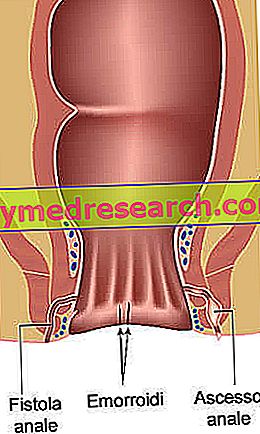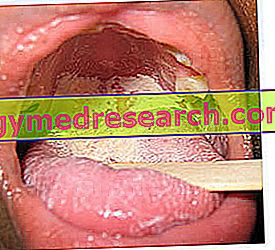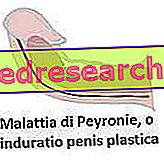Generality
A perianal fistula is a tubuliform lesion (a small canal) that connects the terminal portion of the intestine with the skin around the anus. This channel represents the pathological evolution of an abscess, which in turn originates from the infection of one of the mucus-secreting glands present in the anal canal; from this infection comes a collection of pus, which reaches the skin and tries to make its way outward.

The diagnosis of perianal fistula is based on physical examination, with rectal exploration and palpation of the anus and surrounding tissues. To define the course of the canal and identify any secondary extensions, the doctor may use endoanal ultrasound or magnetic resonance imaging.
The treatment of the perianal fistula is only surgical and is essential to remove the chronic infective process, preserving the integrity of the sphincters and preserving anal continence.
Premise: the perianal abscess
The perianal abscess is a collection of pus that results from an inflammatory process. In most cases, phlogosis is a defense mechanism against an aspecific infection, which affects the microscopic Hermann and Desfosses glands, located within the anal canal. The normal function of these anatomical structures is to secrete mucus to facilitate the passage of feces.
The perianal abscess and fistula represent two different stages of the same pathology:
- The abscess represents the acute phase of an infection that originates from the mucus-secreting glands present in the anal canal;
- The fistula represents a chronic evolution of this suppurative process (infection with pus formation).
The infection spreads in the tissues using the glandular channels and reaches the perianal skin where, due to the resistance opposed by it, it stops. Immediately under the skin, therefore, all the material produced by the inflammatory process accumulates, then evolving into pus.
The factors that can favor the development of a perineal abscess are varied and include alterations of the consistency of the stools (diarrheal syndromes or, on the contrary, the passage of very hard fecal material), some chronic intestinal diseases (such as Crohn's disease and ulcerative rectocolitis) and the sequelae of surgical operations on hemorrhoids and fissures.
The perianal abscess is a very painful condition, which can be accompanied by fever and generalized malaise. The collection of pus, placed immediately in the vicinity of the anus, can escape from the skin that contains it, spontaneously or after a surgical incision.
What's this
A perianal fistula is a kind of tunnel. which has an orifice in the anal canal and the other on the surface of the perianal skin.
The fistula can form spontaneously or represent the complication of various pathological affections of the anorectal region.
In most cases, a perianal fistula is the consequence of the drainage of recurrent abscesses due to a purulent infection.
Classification by Parks
The suppurative process can be arranged in various ways around and through the muscles of the perineal region.
Depending on the type of route, ie the way in which they pass through the sphincters, the fistulas are classified into:
- Intersfinters (70%);
- Transfinters (23%);
- Sovrasfinteriche (5%);
- Extrasfinteriche (2%).
The main routes (or routes) may, in turn, have secondary branches.
Causes
When the abscess, which originates from an anal gland, pierces the perineal skin, a tract (fistula) is formed, which connects the internal orifice with a second opening in the skin.
Therefore, the perianal fistula has:
- An internal or primitive orifice ;
- A via fistula (or route);
- A secondary orifice, generally, external (there are rare cases in which the secondary orifice is internal, as for intramural fistulas of the rectum).
Normally, the Hermann and Desfosses glands favor the passage of the feces, secreting a lubricating mucus in the anal crypts (small depressions in the shape of a swallow's nest that are arranged in the region of the anus in a circular way). The infection results from the penetration of bacteria or foreign material inside the anal gland, which obstructs the duct from which the mucus comes out.
Inflammation - induced as a defense mechanism - determines the collection of pus. Meanwhile, the infection spreads to the surrounding tissues, forming a channel that connects the anal gland (from which the abscess originates) with the skin of the perianal region. In fact, the purulent material seeks a way out to the outside, but remains contained by the perianal skin where, due to the resistance opposed by it, it stops.
When the skin is torn, a fistula is created: the channel through which the pus has passed can persist and the external orifice, close to the anus, remains open.
Predisposing factors
Some pathological conditions, such as diverticulitis, colitis, Crohn's disease or other inflammatory bowel diseases, can make the development of a perianal fistula more likely. Sometimes this lesion is congenital.
Other factors predisposing the development of a perianal fistula are:
- Local traumas (penetration of foreign bodies, anal eroticism, incorrect execution of enemas, hard fecal bolus, etc.);
- Presence of solid residues in the fecal material, which are wedged in the glandular orifice;
- Alteration of pH or stool consistency (eg diarrheal syndromes, constipation, etc.);
- Neoplasms of the anal or rectal tract;
- Complications of surgery (episiotomy, hemorrhoidectomy, prostatectomy, etc.);
- Tuberculosis;
- Sexually transmitted diseases (eg chlamydia, syphilis and venereal lymphogranuloma).
Symptoms, signs and complications
Most fistulas originate in anorectal crypts and connect the inside of the anal canal or the rectum with the perineum.
This injury is typically accompanied by:
- Irritation around the anus with itching, burning and, sometimes, intense pain;
- Intermittent or constant secretion of pus or serous material from a small hole located near the anus, which has no tendency to heal;
- Pain and fever when the fistula becomes infected and causes an abscess again.
The symptoms of perineal fistula tend to be accentuated during defecation and may be associated with the appearance of blood loss and fouling of the laundry (in some cases, the secreted material is mixed with faeces).
The external fistulous orifice can spontaneously close for a variable period, then reopen to secrete serum-purulent material (apparent healing with formation of a new abscess).
In some cases, general symptoms may also occur, such as fatigue, fever and pelvic pain.
If the pathological process of channeling progresses and becomes chronic, involving the perianal surface in different points, it can favor serious damage to the sphincters (muscles surrounding the anus suitable for continence).
Diagnosis
The diagnosis of perianal fistula is based on physical examination, with rectal exploration and palpation of the anus and surrounding tissues.
Upon inspection, the proctologist may encounter one or more secondary external orifices, sometimes with the appearance of a pus-secreting granulation button. On palpation, the perianal fistula can result as a cord-shaped and fibrous subcutaneous lesion, in the direction of the fistulous orifice towards the anus.
In some cases, the internal orifice site may be suspected by finding a hardening or a digitally appreciable dimple in the rectal exploration.
To define the course of the perianal fistula and identify any secondary extensions, the doctor may use some investigations:
- Intraanal ultrasound : it allows to accurately visualize the branches of the infection in relation to the sphincters;
- Magnetic resonance : allows the morphological study of the fistula.
Other tests (rectoscopy, colonoscopy, TAC) allow the exclusion of other associated diseases.
Therapy
The treatment of perianal fistula involves various surgical approaches. In any case, the goal is to eliminate the lesion and prevent recurrences, trying to preserve the continence of the sphincters.
Anal fistula surgery is complex and involves the application of many techniques, chosen according to the specific case. Sometimes, more time is needed. Postoperative pain is mild or moderate and is easily controlled with normal pain medication.
Postoperative hospitalization times are very short (24-48 hours) and home dressings are simple.
The main types of intervention are:
- Fistulotomy : it is typically reserved for patients with simple and low fistulas (intersfinters or inferior transfinters); the procedure involves the flattening of the fistulous path. The technique is associated with a high success rate and is not burdened with a significant risk of incontinence. If diarrhea or Crohn's disease is present, fistulotomy is not recommended. due to delayed wound healing. In these patients, medical therapy can be used with appropriate antibiotics and immunosuppressive drugs.
- Fistulectomy : involves the dissection of the entire perianal fistula and a micro portion of the surrounding healthy tissue.
- Seton placement : it is a technique used in patients with complex fistulas; the treatment involves the insertion of a sort of large suture thread (or a silicone tube) in the path of the lesion, then joined to its two ends outside the body. The setone has two advantages: the continuous drainage of the material contained in the fistulous canal (such as pus) and elastodieresi, ie the possibility of periodically putting the elastic in traction to slowly dissect the muscle tissue, incising a new segment as the previous lesion heals; doing so, clear cuts are avoided and the risk of incontinence is reduced.
- Fistulectomy in two stages : it is performed at different times, in order to minimize the risk of complications, such as damage to the anal sphincter and fecal incontinence. This operation is indicated in the treatment of complex fistulas, which also involve the anal muscles. The first phase involves the positioning of a seton, while the second consists in a fistulotomy or fistulectomy operation.
- Endorectal flap : it consists in the reconstruction of mucosa and submucosa, obtained by applying a well vascularized flap of the rectal mucosa (taken from the overlying rectum) on the internal opening of the fistula (fistulous orifice). With this procedure, the probability of incontinence is 35%.
- Fibrin glue : involves the closure of the perianal fistula through the injection into the previously cleaned fistula gallery of a soluble mixture in order to seal it. The procedure is minimally invasive and ensures a faster return to normal activities. However, the risk of recurrences remains high, with low success rate of definitive healing of perianal fistulas.
- Biological prostheses (anal plug) : the technique involves the positioning of inert devices in the fistula (they do not generate foreign body reactions). These medicated anal plugs promote the generation of new tissue and are then reabsorbed spontaneously by the body. Also in this case, the post-intervention complications are almost nil, including the risks of incontinence; the therapeutic success rate is good (40-80%), but a major risk of recurrence remains.
- LIFT (Ligation of Inter Sphincteric Fistula Tract) : surgical procedure that is based on the closure of the internal fistulous orifice (through the intersphincteric space and not via the endorectal one), in combination with the removal of the infected glandular tissue. Recent minimally invasive, effective and safe technique, with a good success rate and low risk of recurrence.
- VAAFT (Video Assisted Anal Fistula Treatment) : it uses advanced diagnostic tools (operative fistuloscope), which allow to have a direct view of the fistulous path from the inside, also highlighting any local complications. In addition to vision, this device allows you to clean and cure the fistula itself from its inside, following the operating steps on the monitor step by step. The technique is particularly suitable for the treatment of complex perianal fistulas. By treating the lesion from the inside, the risk of causing damage to the sphincters is eliminated; also in this case, therefore, the risk of post-operative incontinence is zeroed.
Prognosis
If well treated, the perianal fistula should not recur. After the surgical treatment, the pathology may recur due to the incomplete drainage of the lesion or the infection of the adjacent spaces.
If the fistula is complex, relapse may depend on many factors, not only related to surgery.
Fecal incontinence can result from iatrogenic damage and is favored by a prolonged action of the purulent material on the sphincters (diagnostic delay).
Recurrence of the disease can be the subject of further treatment, even repeated several times if necessary.



